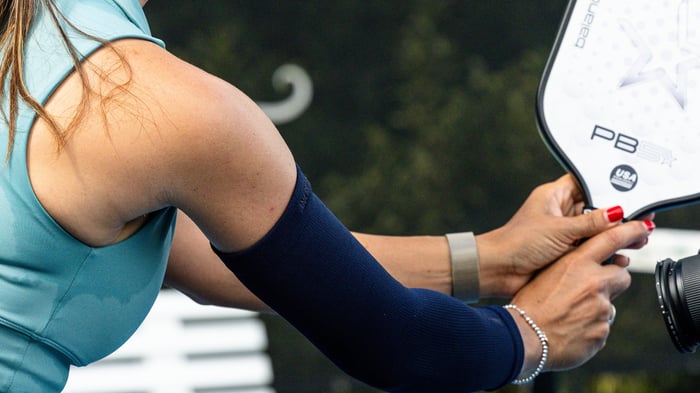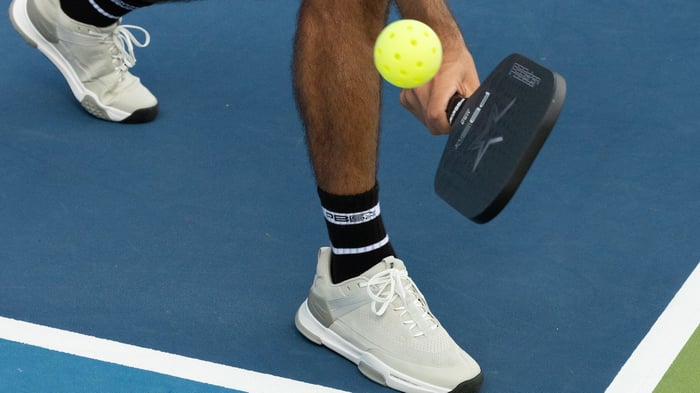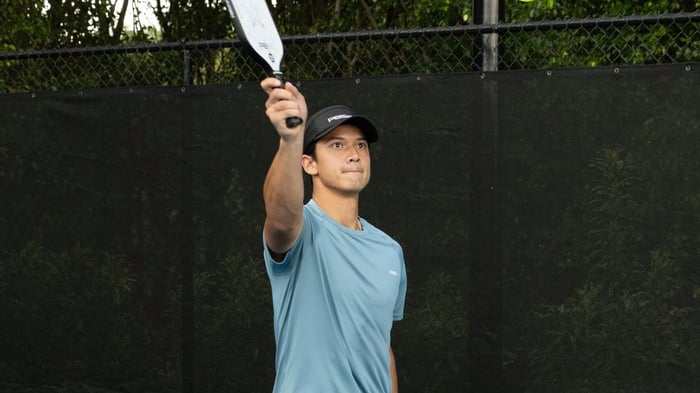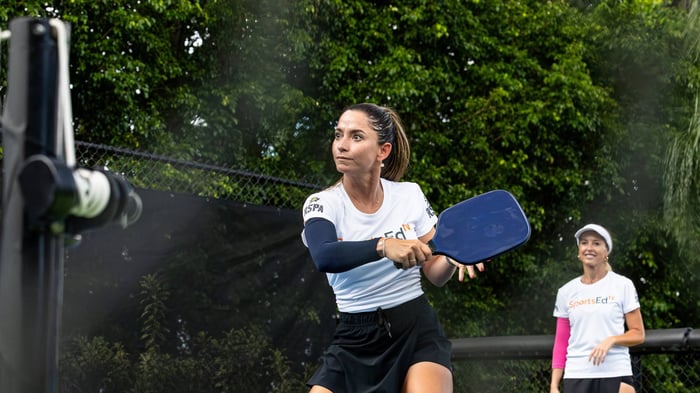Key takeaways:
Mastering the 10 fundamental pickleball rules helps new players feel confident, connected, and ready to enjoy the game.
Understanding unique rules like the double bounce and kitchen line basics creates a more strategic and inclusive playing experience.
The right gear enhances comfort and performance, allowing players to focus on improving their game.
Pickleball is one of the fastest-growing sports in the world, and for good reason. It’s easy to learn, welcoming to all ages, and full of quick, engaging rallies that turn casual players into lifelong fans. Whether stepping onto the court for the first time or brushing up on the basics, understanding the foundational rules helps you play confidently and connect with a vibrant, inclusive community.
Learning the ins and outs of pickleball doesn’t have to be overwhelming, especially when you’re supported by the right mindset, helpful players, and reliable gear. At PB5star, we believe the right paddle, apparel, and accessories can make every beginner feel like a seasoned pro from day one.
What every new pickleball player needs to know
Walking onto a pickleball court for the first time can feel nerve-wracking, but understanding the basic rules creates an instant sense of belonging. Grasping the basics means joining a sport where experienced players mentor newcomers, making age irrelevant. The beauty of pickleball lies in how quickly newcomers can rally with seasoned players, transforming strangers into friends.
#1. Mastering the pickleball serve rules
The serve is the starting point of every rally in pickleball, and getting it right is essential. These basic rules will set a strong foundation for consistent, strategic play. A solid serve receives the ball in play and gives you an early edge in controlling the point.
Use an underhand motion to serve: All serves must be made with an upward, underhand stroke, keeping the paddle below waist level.
Land the ball in the correct service box: The serve must travel diagonally across the court and bounce within the opposite service box, beyond the non-volley zone.
Avoid common serving faults: Faults include hitting the ball above the waist, stepping on or over the baseline before contact, or missing the service box entirely.
Mastering your serve early helps you build momentum, avoid faults, and enjoy longer rallies. It’s one of the most essential skills to develop to grow your confidence and success on the court.
#2. Understanding the double-bounce rule
The double-bounce rule, often called the two-bounce rule, is one of pickleball's most player-friendly features. After the serve, the ball must bounce once on the receiving side before the return, and then that return must bounce once on the serving side before anyone can hit the ball in the air.
Breaking this rule results in an immediate fault, meaning you lose the serve or the point. Common mistakes occur when players attempt to hit the return before it bounces. Players can hit volleys once the first two bounces happen, but those initial exchanges must hit the ground first. Understanding this basic rule helps new players feel more confident about when they can attack the ball.
#3. Respect the kitchen line basics
The non-volley zone, affectionately called "the kitchen," might sound like a cozy place, but it's a 7-foot area on both sides of the net where volleys are strictly off-limits. Understanding these kitchen line basics will help you develop more intelligent court positioning.
Avoid the zone during volleys: You cannot hit the ball in the air while any part of your body, paddle, or clothing touches the kitchen lines or the zone itself.
Keep both feet completely outside: Position both feet beyond the 14-foot-wide non-volley zone before attempting any shots in the air.
Remember the paddle rule: If your paddle touches the kitchen while hitting the ball in the air, it's a fault even if your feet stayed clean.
Respecting the kitchen is more than just following the rules; it’s key to unlocking the strategic heart of pickleball. You'll stay legal, play smarter, and keep the rally going by controlling your position and embracing soft-touch techniques near the net.
#4. Get familiar with scoring in pickleball
The most important thing to understand about pickleball scoring is that only the serving team can score points. When you're receiving, you play defense to win the rally and regain the serve. This creates alternating offense and defense rhythm, making every rally count. Most recreational games go to 11 points with a 2-point win margin, while tournaments may play to 15 or 21, but the win-by-two rule always applies. This format keeps games fast-paced and competitive.
Before each serve in doubles play, announce the score using a three-number system: your team's score, your opponents' score, and which server you are. For example, "5-3-1" indicates your team has 5 points, your opponents have 3, and you're the first server. Learning this format may feel awkward initially, but mastering scoring prevents confusion and fosters clear communication, maintaining the friendly spirit that makes pickleball welcoming.
#5. Recognizing faults and lets
Faults and lets might sound intimidating, but they're just part of the game's rhythm that keeps everyone playing fair and having fun. When you understand these calls, you'll feel more confident stepping onto any court and can help create that welcoming environment where new players thrive.
Understand when faults occur during serving: The most common serving faults happen when the ball doesn't land cross-court in the proper service box.
Create a supportive learning environment: When faults and lets come up during play, use them as opportunities to encourage newer players and share knowledge.
Focus on fair play over fault-finding: Understanding these rules helps you play confidently and contributes to the positive, inclusive community spirit. It’s also helpful to know that a mis-hit like a carry, where the ball is lifted or pushed instead of struck cleanly, counts as a fault and can quickly shift momentum in a rally.
Learning to navigate faults and lets is essential not just for improving your game but also for building community on the court. Approaching these moments with patience and clarity makes the game more fun, fair, and friendly for everyone.
#6. Knowing your court boundaries
Understanding court boundaries is essential for fair play in pickleball. A standard court measures 20 feet wide and 44 feet long, with lines marking the playing area. Any ball touching a boundary line is "in," including the baseline, sidelines, and centerline. However, a serve landing on the kitchen line is "out," as serves cannot enter the non-volley zone.
Mastering these boundary rules fosters trust and camaraderie among players. Disputes are rare when everyone knows what's in and out, allowing games to flow smoothly. This shared understanding creates a welcoming environment, making pickleball enjoyable in casual games or organized tournaments.
#7. Find your best paddle grip tips (and gear up for comfort)
Your paddle grip connects you to every shot, so getting it right makes all the difference in your comfort and control. Most beginners benefit from starting with the Continental grip, also known as the hammer grip, which allows for a broader range of shots as you develop your game.
Start with the Continental grip: Hold your paddle like you're shaking hands, creating a versatile foundation that works for most shots and feels natural for newcomers.
Experiment with grip wrapping: Try different thicknesses and materials to find what reduces hand fatigue and prevents slippage during longer games.
Build confidence through comfort: When your paddle selection and gear feel right, you'll play longer and connect more easily with other players.
Dialing in your grip and comfort isn't just about performance; it’s about feeling confident and at ease every time you step on the court. With the right setup, your focus can shift from mechanics to strategy, allowing your game and social connections to thrive.
#8. Practice good pickleball etiquette
Practicing good pickleball etiquette starts with simple respect and courtesy that enhances everyone's enjoyment. Always call out the score clearly before each point, greet your opponents, and apologize if you hit a ball into another court. Accidents and stray shots are part of the game, but handling them with calm communication keeps matches safe and enjoyable for everyone. These small gestures foster the welcoming energy that defines pickleball.
Timing is crucial for ball retrieval; wait for points to finish before chasing stray balls and avoid walking behind players in a rally. If a ball from another court rolls onto yours, call "ball on court" to pause play safely. Positive communication and encouragement are key; celebrate great shots and support your partner, regardless of the outcome.
9. Embracing sportsmanship in pickleball
Great sportsmanship in pickleball means celebrating the game itself, not just your success. Acknowledge your opponent's brilliant shots and maintain respectful behavior throughout the match. Cheering for outstanding plays and treating every player courteously fosters a welcoming environment.
Disputes are inevitable, but handling them with patience enhances everyone's experience. Approach line calls and scoring confusion with a willingness to find fair solutions. Good sportsmanship prioritizes enjoyment over winning, creating lasting friendships and a community where players of all skill levels feel comfortable joining.
#10. Building court confidence for beginners (with a little help from your gear)
Court confidence for beginners grows naturally when you combine the right mindset with supportive gear. The pickleball community thrives on helping newcomers feel welcome, and having equipment that makes you prepared can transform those first-game jitters into genuine excitement.
Start with regular practice: Every experienced player started exactly where you are now, so focus on improvement rather than perfection.
Ask questions freely and connect with other players: The pickleball community loves sharing knowledge, and most players are happy to offer tips or explain rules during casual games.
Invest in proper court shoes for stability: Proper footwear, like those from PB5star’s collection, prevents slips and gives you the foundation to play with assurance.
Confidence takes time to develop through practice, connection, and the right equipment. When you feel supported by your gear and community, you’ll find joy in your progress and quickly feel at home on the court.
Frequently asked questions (FAQs) about pickleball rules
New players often have questions beyond the basic rules, and asking them makes our pickleball community so welcoming and supportive. These common pickleball rules FAQ topics come up regularly when we're mentoring newcomers, and getting clear answers helps everyone feel more confident stepping onto the court.
What happens if the ball hits the net on a serve?
If your serve hits the net and still lands in the correct service box, it's called a "let," and you get to serve again. However, if the ball hits the net and doesn't make it over, or if it goes over but lands outside the service box, that's a fault and you lose your serve.
Can you volley in the kitchen if the ball bounces first?
Yes, you can hit the ball in the non-volley zone (kitchen) as long as it bounces first. The kitchen rule only prevents you from volleying, hitting the ball out of the air, while standing in that 7-foot zone on each side of the net. Once the ball bounces, you can step in, make your shot, and then step back out.
How do you resolve scoring disputes?
If there's genuine confusion about the score, replaying that point works best. Most recreational games use the honor system, so if players can't agree, replaying that point keeps things friendly. Many experienced players suggest announcing the score loudly before each serve to prevent these situations from happening.
Your pickleball journey starts here
Pickleball’s true magic lies in its ability to unite people, regardless of age, experience, or background. When new players understand the core rules, practice good etiquette, and show up with curiosity, they quickly become part of the community. With just a bit of preparation and encouragement, anyone can enjoy the fast-paced rallies, strategic fun, and friendships that make this sport addictive.
Confidence on the court starts with knowledge, grows through experience, and is strengthened by the gear that supports your game. At PB5star, we’re here to equip you with paddles, apparel, and accessories that help you feel ready, play better, and look great every time you step on the court.







